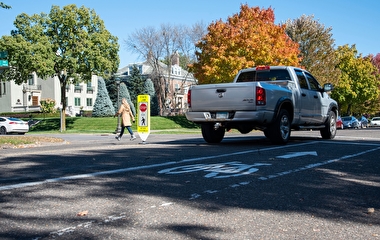
Increasing active transportation is an ongoing effort for transportation planners. Biking and walking can help decrease auto dependence, air pollution, and climate change and improve public health. Plus, it can help transportation agencies meet their strategic goals. The challenge? Making good decisions requires good data, and data for walking and biking trips can be hard to find.
To fill the data void, transportation planners typically rely on estimation models. However, even these models require high-quality data inputs. In a recent study, U of M researchers led by Raphael Stern looked at the use of crowdsourced mobile data to estimate pedestrian and bicycle traffic.
In a review of existing literature, the research team sought to identify what types of crowdsourced mobile data have been used to estimate pedestrian and bicyclist traffic volumes, which methods have been employed in the estimation process, and how crowdsourced mobile data performs in the estimation.
Researchers found that fitness apps (particularly Strava) have been the most-used source of crowdsourced data, and that most studies use it to estimate bicyclist volumes. They also found that crowdsourced data appears to work: including it can significantly improve estimation performance in studies.
Finally, researchers identified future research directions. These include applying crowdsourced data in more pedestrian traffic estimations, comparing the performance of different crowdsourced mobile data, incorporating multiple data sources, and expanding the methods of using crowdsourced mobile data for estimating nonmotorized traffic.
This research is published as an article in the Journal of Transport and Land Use, the official journal of the World Society for Transport and Land Use. The journal is published and sponsored by CTS.
The research is part of an active research project led by Stern, an assistant professor in the Department of Civil, Environmental and Geo-Engineering (CEGE). Others on the team include co-investigators Michael Levin, CEGE assistant professor; Greg Lindsey, professor in the Humphrey School of Public Affairs; and Humphrey School graduate Tao Tao, now a postdoctoral researcher with Carnegie Mellon University. The project is funded by MnDOT and the Minnesota Local Road Research Board.
—Megan Tsai, contributing writer


